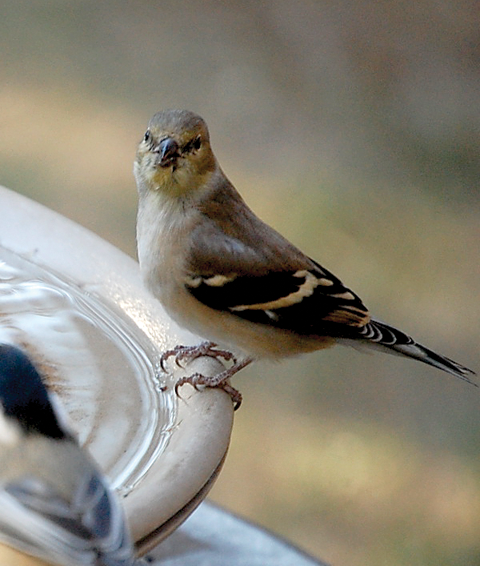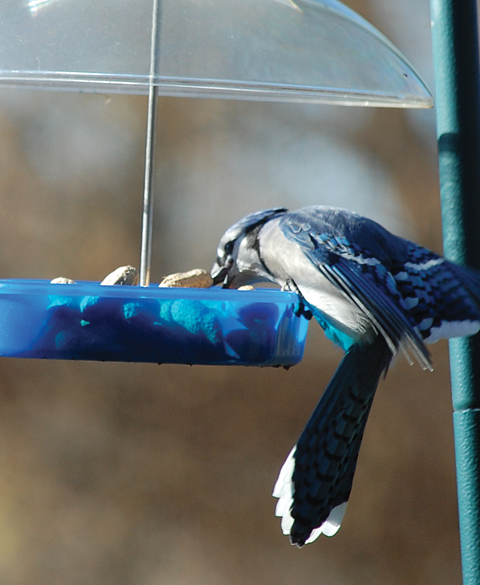Fall seasonal tips and observations
Your Autumn Backyard Checklist
- Orioles leave the first week of September and migrate to the neo-tropics.
- Migrating hummingbirds will continue to visit your feeders into October. Keep your hummingbird feeders up until you don’t see any hummers for a week, or until the nectar freezes.
- September is the main month for the southward migration of warblers, vireos, grosbeaks and sparrows. Blue Jays migrate in flocks across Minnesota. Early September is the peak time for monarch migration as well. Follow migration on journeynorth.org .
- Indian Meal Moths are very active in September. To prevent unwanted guests, store your seed in metal garbage cans on the deck, in the garage or in the shed and only buy as much as you will use in six weeks. For easy access, store smaller quantities in the freezer. To remove moths install a moth trap.
- Feed goldfinches all year long. They are quite fond of golden safflower as well as Nyjer® and Nyjer® mixes. Nesting season is over and they don’t need their bright yellow plumage to attract a mate. The males’ winter plumage is a dull olive green, similar to the females’ plumage which helps to protect them from predators.
- Update or add to your pole system before the ground freezes. We’ll be glad to help you choose what’s best for your yard.
- Keep a watch for the robins and waxwings feeding on berry trees, like Mountain Ash, Viburnums, and Dogwoods.
- Consider a heated birdbath for the upcoming winter. Birds that don’t ordinarily go to bird feeders, like over-wintering Robins, will always enjoy a clean water source.
- If you used a heated birdbath last winter, use white vinegar to remove any lime scale.
- Seeds and mixes without shells such as Select Sunflower Hearts or Kracker Jax are less work for the birds to eat and less mess for you. A win-win.
- Help Blue Jays with their food cache by filling an in-shell peanut feeder.
- Juncos are coming! Scatter Finches’ Choice or Spectrum on the ground or in a ground feeder for these winter visitors. White-throated Sparrows, White-Crowned Sparrows and Mourning Doves are also ground feeders that will enjoy this treat. To avoid gray squirrels in the screened bottom ground feeder fill it with white millet, golden safflower and Nyjer® to attract cardinal, mourning doves, juncos and native sparrows. Chipmunks hibernate for most of December and into February and won’t be raiding the ground feeder.
- Host winter visiting Red-breasted Nuthatches with peanut pick-outs, suet and mealworms. Many of your favorite backyard birds also love these high fat treats, including Chickadees, Woodpeckers and White-breasted Nuthatches.
- Clean out birdhouses. Leave one or two up all winter in a sunny spot for chickadees, downy woodpeckers and overwintering bluebirds to huddle in this winter.
- Close up purple martin houses.
- Don’t cut the seed heads from your perennials. Birds will eat these seed heads into the winter. Particularly valuable are Purple Coneflower, Black-Eyed Susan, Sunflowers, and Hollyhock.
- Add a large capacity feeder to reduce the number of trips out in the snow to refill this winter. Try the Mr. Bird large sized seed cylinders- seed and gelatin are compressed into cylinders, no loose seed. This limits bill sweeping behavior mess as well.
- Give your feeders a good cleaning before winter. Use hot water and a mild dish detergent. Rinse the feeders with clear water for at least 10 seconds and make sure that it’s completely dry before refilling. We offer a bird feeder cleaning service if you’d rather have us do it!

Nesting season is over and male American Goldfinches don’t need their bright yellow plumage to attract a mate. Their winter plumage is a dull olive green, similar to the females’ plumage, which helps to protect them from predators.

Peanut-in-the-shell feeders attract nuthatches, woodpeckers, Blue Jays and more.
Seasonal Observations
- September 1 is the first day of meteorological fall.
- Monarchs continue to migrate south one by one at about 11 mph. They visit Autumn Joy sedum, wild asters, goldenrod and Mexican sunflowers. By November they will be wintering in mountain forests west of Mexico City.
- Blue Jays, Red-bellied Woodpeckers, Wild turkeys and Wood Ducks feast on acorns falling from red and white oaks.
- Crows gather in communal groups.
- Fall warbler migration continues—watch for Chestnut-sided and Magnolia warblers.
- Peak bird migration over Hawk Ridge in Duluth is typically the second week of September. Clear skies and northwest wind provide the best conditions for fall migration.
- Snapping turtles hatch out of clutches laid upland in late May or early June.
- The chorus of grasshoppers, crickets and katydids has replaced bird song.
- Rafts of coots and Franklins Gulls return to area lakes.
- Ruby-throated Hummingbirds leave northern MN but more southern parts of the state will continue to see them at feeders.
- About the third week of September, Dark-eyed Juncos arrive and ground feed under feeding stations. It is also peak fall migration time for Yellow-rumped warblers.
- 9/22 is the autumnal equinox—autumn officially begins.
- The first killing frost in the metro is typically the last week of September or the first week of October, signaling the end of the growing season.
- Birdbaths may ice over at night—time to plug in the heated birdbath!
- Watch for the arrival of the White-throated sparrow. They will join the Dark-eyed Juncos on the ground under the feeders.
- Groups of Common Loons gather on area lakes in preparation for migration to the Gulf Coast or Atlantic seaboard.
- The first Snow Buntings return and can be seen in roadside ditches and farm fields.
- Northern Flickers migrate through the area, though some do winter here.
- In early October some migrating hummingbirds visit nectar feeders before leaving to winter in south Texas to Costa Rica.
- Watch for waves of migrating American Robins and Cedar Waxwings. They love a fresh birdbath!
- Golden-crowned and Ruby-crowned Kinglets appear in woodlands as they migrate. The last of the Yellow-rumped warblers, Palm warblers, Vireos and Flycatchers leave Minnesota for the winter.
- In mid-October, late season butterflies like Clouded Sulfurs, Red Admirals, Painted Ladies and a few Monarchs can be seen on New England asters and Mexican sunflowers.
- Migrating waterfowl include the American Wigeon, Blue-winged Teal and Northern Pintails.
- During the third week of October, Turkey Vultures glide southward overhead.
- Fox, White-throated and American Tree Sparrows join the White-crowned sparrows and Dark-eyed Juncos ground feeding.
- Waterfowl migration is in full swing—watch for Red-heads, Canvasbacks, Lesser Scaup and Northern Shovelers.
- Toads dig down below the frost line and beavers are busy cutting trees for their winter stores.
- By late October the majority of the Eastern Chipmunks have begun hibernation.
- Goldfinches are in their brownish winter plumage. They feed in mixed foraging flocks and are active at feeders all winter.
- Listen for the whistling call of the Tundra Swans as they migrate high overhead. They are migrating to their wintering grounds along the Atlantic coast.
- Bald and Golden Eagles, Rough-legged Hawks, Sharp-shinned Hawks, Northern Goshawks and Merlins are seen migrating over Hawk Ridge in Duluth.
- Though most deciduous trees are bare, the leaves of the red oak, pin oak and white oak persist in dark reds and browns.
- November is typically a cloudy month but the sunsets are exceptional. We average one sunny day a week in November. It is also a month of big waterfowl migration.
- Area lakes host large rafts of American Coots and Franklin’s Gulls.
- Eagles gather along the Mississippi river.
- During the third week of November, raccoons typically enter their winter sleeping dens. They don’t truly hibernate as the will forage at night when temperatures are 27* or higher.
- Flying Squirrels do not hibernate and may use bird feeders at night. Opossums have become more frequent under backyard bird feeders but are mostly nocturnal.
- Pine Siskins, Red Polls, and Purple Finches may join the goldfinches and House Finches at the Nyjer® and Nyjer® mix feeders throughout the winter.
- Watch for Brown Creepers spiraling up and around tree trucks as they search for larvae and insects.
- In the southern half of Minnesota, crows are regularly seen throughout the winter. They gather in large flocks to roost together in trees overnight.

